





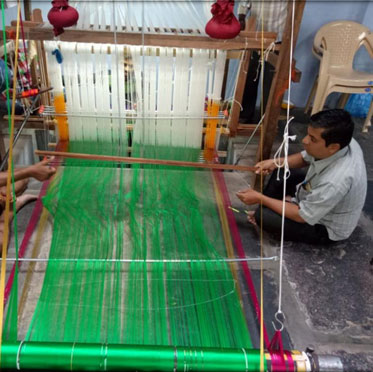
Dharmavaram Handloom Pattu Sarees
Dharmavaram Handloom Silk Sarees are exclusively woven on Handlooms. The Raw material i.e., silk is extracted from 100% quality of Mulberry cocoons for weaving Dharmavaram silk Sarees. Designs of sarees mostly represent flora and Fauna i.e., Flowers, Leafs, fruits, pictures of Epics like Ramayana, Mahabharata peacock, Elephants etc
The borders, pallu and body of the saree are designed differently. All the designs are made with the gold colour zari. The zari for borders is used in warp and for pallu and body zari is used in weft. Zari of Half fine (Twisted) quality is obtained exclusively from Surat of Gujarat State. Zari in Silver, Green, pink Colour are used in Extra warp and extra weft are used in less quantities. There are 10,000 to 11,000 Silk threads are used for total saree.
Depending upon the requirement, 2-4 shuttles are used for weaving. At the beginning for weaving blouse one shuttle is used and in similar colour pirn is used. All motifs like buttas, beat buttas, fancy buttas, Kalanjali, shoulder work design, meenas, these are purely hand woven with extra zari, using less quantity extra silk weft. View Vendor List...

Nimmalakunta Leather Puppetry Craft
The Art of Leather puppetry craft is an ancient form of folk Arts in Andhra Pradesh, India. It was an Art of Livelihood in Ananthapuramu District of Andhra Pradesh, while Nimmalakunta, a remote village in Dharmavaram Mandal is famous for it. Many puppetry Artists from this village have shown extraordinary efforts in this Art. This art was famous by the name Tholu Bommalata which is best described as a composite art containing the fine arts of music, sculpture and painting.
The colours stand out beautifully and figures are magnified or shortened by varying the distance between the light and the puppets. The ancient form of this Art has been transformed into Craft Art by the way of interior designing and giving livelihood opportunities in the region.
At present, the items made through this craft are lamp shades, paintings, wall hangings, door hangings, partitions and modern puppets which are very popularly used in interior designing. Nearly 150 types of items are made in this village as household activity. Importance is being given to Indian epics like Ramayana, Mahabharata and Bhāgavata in preparation of models and puppets as well as modern designs as a background theme. These brilliantly crafted puppets were once the mainstay of riveting performances of episodes from the Indian epics. Western designs are also practiced by the village artists, keeping in view of the tourists who visit regularly to nearby pilgrim sites. View Vendor List...
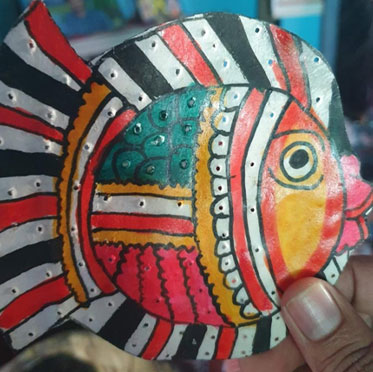

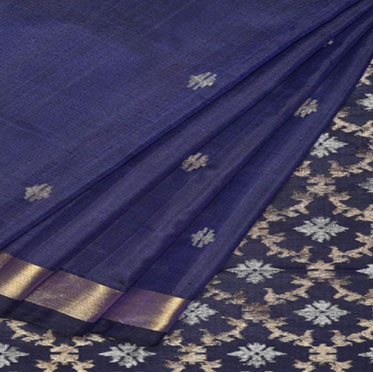
UPPADA JAMDANI SAREE
Uppada jamdani sarees are diaphanous silk sarees that trace its origin to Uppada village in Andhra Pradesh. Jamdani is handwoven fabric and is also known as muslin. The word roughly translates into flower vase (where jam means flower and dani means vase). The name has a Persian origin but the weaving technique of jamdani has Bengali roots. The Uppada form of jamdani has roots in east Godavari.
Historically speaking, jamdani as a technique was first written in Kautilya Arthshastra. The book dates to third century. This style of weaving was widely present in Bangladesh. At the time when the trade between the two places and their kings flourished, this weaving system also seeped down to east Godavari. Eventually, east Godavari villages started bulk production of Uppada. Artisans here generation after generation became quiet adept in this art.
Jamdani is created in remarkably interesting manner. Two weavers are required to sit in a pit loom. They work in tandem to make the fabric. The weft and warp threads are needed for the background are passed from one weaver to another and vice versa. The threads of designs that needed to be weaved in are added and embroidery is done. The design blends into the cloth with its margins are clearly visible and distinct and distinguishable on both sides. On the reverse side, there are no loose ends, threads or knots. At times, it takes months to prepare an Uppada saree of high design. View Vendor List...

Bobbili Veena
Musical instruments have been a part of our rich cultural heritage for a long time and India is known for its finest and rare traditions of music and exclusive part of inventing and making musical instruments. Veena is a very famous musical instrument used in various themes and classical themes. ‘Bobbili veena’ which is also known as ‘Saraswati veena’ or ‘Ekandi veena’ came in to existence in 19th century in response to challenge thrown at artisans of Vijayanagaram by Mussana chinnayya with respect to crafting quality Veena. Sarva Siddhi Acchanna with the permission of Zamindar and connoisseur Raju Ravu Venkata Krishna Rangarao prepared veena from Bobbili samastanam with different sound and structure.
Bobbili veenas are carved out of single peace of Jackfruit wood which is considered best for musical instruments. The Bobbili veena trough is roughly 14.5 inches and it has seven threats made of bell metal. Other veenas have threads made up of same number but are often made up of brass. The earlier patti veena 42 inches long one whereas this instrument is 54inches long.
As part of spreading cultural heritage miniature, Bobbili veenas have been presented to guests such as Mr Bill Clinton, the 42nd president of the United States. View Vendor List...
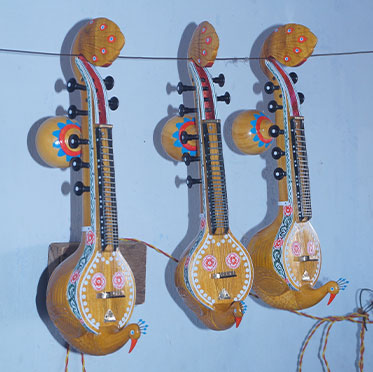

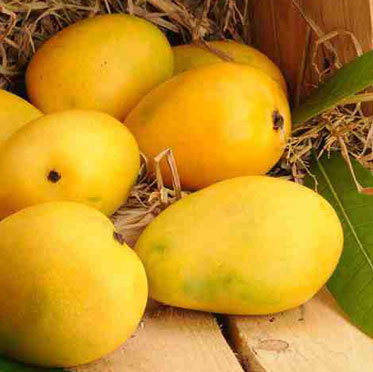
Banaganapalli mangoes
Banaganapalli mango is named after the town in Andhra Pradesh, Kurnool District whose farmers first introduced the Mango variety. Nawab of Banaganapalli encouraged the cultivation of the fruit. It is also known as Benishan or Beneshan of Safda. The skin of Banaganpalli Mangoes is thin with very light spots. The colour of the ripened fruits is golden yellow (primuline yellow), the texture of the pupp being pulpy (firm to meaty) and fiberless. The pulp content is 75-80%, stone is 10-15% and the skin is 5%.
It is mainly cultivated in the mandals of Banaganapalli, Panyam and Nandyal of Kurnool District. In addition, Coastal and Rayalaseema areas also cultivate this variety. The state of Telangana also ha it cultivation in some districts of Khammam, Mahabubnagar, Rangareddy & Medak.
Distinguishing characteristic of this mango is that it has soft skin with very light spots, Oblong in shape. It has thin seed surrounded by soft juicy tissue. It got GI tag in 2017 under horticultural products by Geographical Indication registry. This is also called as ‘King of Mangoes’.
Socio-economic status of mango farmers are mostly small and marginal farmers. On an average, 1.5 acre is the average holding of the Mango farmer. They earn on an average 50,000 per acre in a year. Average yield is 4 MT per acre. They export the best quality mangoes to US, UK, Europe, Japan Middle east etc. View Vendor List...




